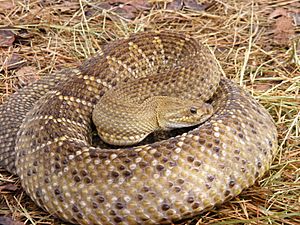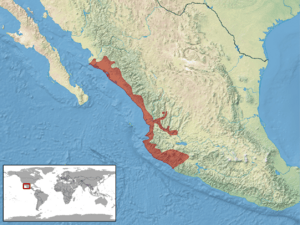Mexican west coast rattlesnake facts for kids
Quick facts for kids Mexican west coast rattlesnake |
|
|---|---|
 |
|
| Conservation status | |
| Scientific classification | |
| Genus: |
Crotalus
|
| Species: |
basiliscus
|
 |
|
| Synonyms | |
The Mexican West Coast Rattlesnake (Crotalus basiliscus), also known as the "Mexican Green Rattler" or the "Mexican West Coast Green Rattlesnake", is a type of venomous pit viper species. The scientific name comes from the Greek word for 'King', basiliskos, because of the snakes large size and dangerous venom.Currently, no subspecies are recognized.
Contents
Description
The Mexican West Coast Rattlesnake is one of the largest rattlesnake species. Ones which have the length of 150 centimetres (4.9 ft) are common, while the maximum size is reported to be 204.5 centimetres (6.71 ft).The young are mostly red but when they become adults their color changes to olive green or yellowish cream.
Habitat
This snakes are found in western Mexico, from southern Sonora to Michoacán. They live in areas which are treeless, are covered in short grass, thorny bushes and have plenty of cactus.
Feeding
Not many know what this Rattlesnake eats, but scientist found seven Mexican West Coast Rattlesnakes which had mammal hair inside them, probably belonging to rodents.
Behavior
In the lowlands, these snakes are active during the raining, summer months and some have been found crossing the roads at night. However some have been seen basking early in the morning. It has been reported that the Mexican West Coast Rattlesnake can be tamed easily in zoos.
Images for kids
-
C. basiliscus at Wilmington Serpentarium in North Carolina, United States
See also
 In Spanish: Serpiente de cascabel de la costa oeste de México para niños
In Spanish: Serpiente de cascabel de la costa oeste de México para niños



